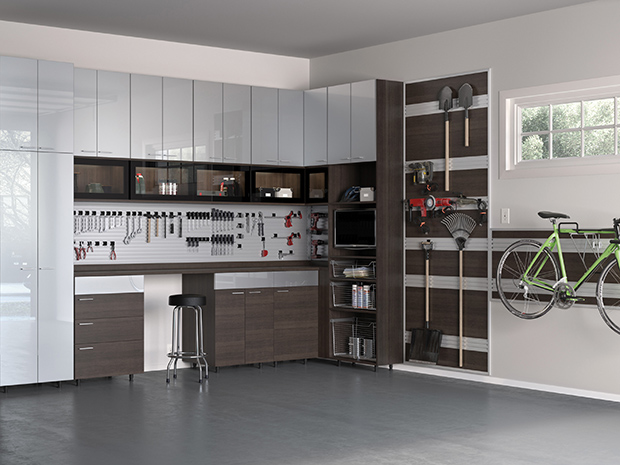
The LiftMaster 3585 3/4 Horse power Belt Drive Garage Door Motor Replacement is a reliable, strong and quiet replacement for your old garage door motor. It can fit single- or double-bay garage door openings. It can lift up to the highest garage doors with its steel-strengthened frame and belts.
Check the limit on the motor. Your garage door will not close if it is set too low. However, a high limit will cause it to stop running. The limit adjustment screw in a garage door opener allows you to change the setting to your liking. However, if your limit adjustment screw doesn't work, you need to replace it.
A professional can help you if your garage door has stopped working. A technician can diagnose the problem, and then repair it. He will also be able to reset the code on your motor so that it is again able to recognize the keypad.

Before calling a technician to fix your garage door, make sure you inspect it for any potential problems. Clear any small items or debris that may be obstructing the door's ability to close it. Clean the tracks on each side of your garage door. These parts of your opener are susceptible to rust. The springs will move more smoothly if they are cleaned.
If your door is noisy, you might need to lubricate its springs as well as the rollers. It will also help to prevent rusting. The overhead springs and rollers can be made to move more smoothly by using light household oil.
If the door still does not close, you might have a broken spring. To replace the garage door spring, disassemble the motor and take out the pulley. Two C-clamps with a couple of box wrenches are required to disassemble the garage door spring. Unbolt your safety cable and remove the safety pulley.
A malfunctioning garage door opener is another cause of stuck garage doors. This can happen whether you have a screwdrive opener, a cable-driven opener or a beltdrive opener. Each type of garage opener has an adjustment screw. For a belt-drive opener, you will need to install a new belt. The chain that drives your door opens will need replacing.

Broken photo-eye sensors are another possible problem. Your photo-eye sensors are located at the bottom of your garage opening. When the photo-eye sensor is broken, the door will not close. Sometimes, the door will stop halfway through. Dust and debris could be the cause. There are ways to clean and align your photo-eyes to fix the problem.
A final possibility is if the motor is working but the door is not. This is often due to a motor that has burned out. This can also happen if you set the limit incorrectly.
FAQ
Are there any savings on a remodel of a bathroom or kitchen.
Remodeling your bathroom or kitchen is expensive. However, when you consider how much money you pay each month for energy bills, upgrading your home might make more sense.
Small upgrades can help you save thousands of dollars per year. A few simple changes, such as adding insulation to walls and ceilings, can reduce heating and cooling costs by up to 30 percent. Even a small improvement can make a difference in comfort and increase resale.
When planning for renovations, it is important to select durable and easy-to-maintain products. Material like porcelain tile, stainless-steel appliances, and solid wood flooring are more durable and can be repaired less often than vinyl or laminate countertops.
It is possible to reduce utility costs by replacing older fixtures with more modern models. Low-flow faucets and showerheads can reduce water consumption by as much as 50%. Replacing inefficient lighting with compact fluorescent bulbs can cut electricity consumption by up to 75 percent.
What is it worth to tile a bathroom?
You might want to go big if you are going to do it yourself. A full bathroom remodels an investment. But when considering the long-term value of having a beautiful space for years to come, it makes sense to invest in quality materials and fixtures.
The right tiles can make a huge difference in how your room looks and feels. This quick guide will help with your selection of the best tiles, no matter if you're looking for small or big projects.
First, decide which type of flooring you'd like to install. Ceramics, porcelain, stone, and natural wood are common choices. Then, select a style--like classic subway tile or geometric patterns. Select a color palette.
A large bathroom remodel will require you to match the tile in the room. For example, you may opt for white subway tile in the kitchen and bath area while choosing darker colors in other rooms.
Next, consider the size of your project. Are you ready to renovate a tiny powder room? Or would you rather add a walk-in closet to your master suite?
After you have established the project's scope, it is time to visit local stores and view samples. You can then get a feel of the product and how it is installed.
You can also shop online to find great deals on porcelain and ceramic tiles. Many sellers offer discounts and free shipping for bulk orders.
What are the main components of a full kitchen renovation?
A kitchen remodel includes more than a new faucet and sink. You can also get cabinets, countertops or appliances, as well as flooring and plumbing fixtures.
Homeowners can remodel their kitchens completely without needing to do major work. This means there is no need to tear down the kitchen, making the project more manageable for both the homeowner as well as the contractor.
Renovating a kitchen can involve a range of services including plumbing, heating and cooling, painting, and even drywall installation. Depending on the scope of the project, multiple contractors might be needed to remodel a kitchen.
Professionals with years of experience working together are the best way ensure a successful kitchen remodel. Many moving parts can cause delays in kitchen remodels. If you choose a DIY approach, make sure you plan and have a backup plan in place in case things go wrong.
What should I do about my cabinets?
It depends on whether you're considering selling your home or renting it out. You will need to take down and refinish your cabinets if you are selling. This gives buyers the illusion that they are brand new, and allows them to envision their kitchens once they move in.
However, if you want to rent your house, you should leave the cabinets alone. Many tenants complain about cleaning up after their previous tenants, including greasy fingerprints and dirty dishes.
You could also paint the cabinets to give them a fresh look. Just remember to use a high-quality primer and paint. Low-quality paints can become brittle over time.
How can I tell if my house needs a renovation or a remodel?
First, consider whether your home has been updated in recent times. It may be time for a renovation if your home hasn't been updated in a while. If your home appears brand-new, you might consider a renovation.
A second thing to check is the condition of your house. A renovation may be necessary if your home has holes in its drywall, cracked wallpaper, or missing tiles. It's possible to remodel your home if it looks good.
Also, consider the general condition of your property. Is your house structurally sound? Do the rooms look clean? Are the floors spotless? These are vital questions to ask when you decide which type of renovation should be done.
How much would it cost to gut a home vs. how much it cost to build a new one?
Gutting a home removes everything inside a building, including walls, floors, ceilings, plumbing, electrical wiring, appliances, fixtures, etc. Gutting is done when you want to make some modifications before moving in. The cost of gutting a home can be quite expensive due to the complexity involved. Your job may require you to spend anywhere from $10,000 to $20,000 to gut your home.
Building a home is where a builder builds a house frame by frame, then adds walls, flooring, roofing, windows, doors, cabinets, countertops, bathrooms, etc. This usually happens after you have purchased lots of lands. Building a home usually costs less than gutting and can cost between $15,000 and $30,000.
It all comes down to what you want to do in the space. If you want to gut a home, you'll probably need to spend more because you'll be starting over. It doesn't matter if you want a home built. You can build it as you wish, instead of waiting to have someone else tear it apart.
Statistics
- Attic or basement 10 – 15% (rocketmortgage.com)
- 55%Universal average cost: $38,813Additional home value: $22,475Return on investment: 58%Mid-range average cost: $24,424Additional home value: $14,671Return on investment: (rocketmortgage.com)
- About 33 percent of people report renovating their primary bedroom to increase livability and overall function. (rocketmortgage.com)
- Windows 3 – 4% Patio or backyard 2 – 5% (rocketmortgage.com)
- 57%Low-end average cost: $26,214Additional home value: $18,927Return on investment: (rocketmortgage.com)
External Links
How To
How to Remove Tile Grout on Floor Tiles
Most people don't know that tile grouting exists. It is used to seal joints between tiles. There are many types of grout available today. Each one has a different purpose. We will show you how tile grout can be removed from floor tiles.
-
First, you must ensure you have all the tools needed before starting this process. It is a good idea to have a grout knife, grout scraper, as well as some rags.
-
Now it is time to clean the grout and remove any debris or dirt that has gotten under the tiles. Use the grout knife to remove the grout. Scrape away any remaining grout. Be careful not to damage any of the tiles.
-
After cleaning everything, take out the grout scraper. Use it to clean up any grout left behind. You can move on to step 4 if there is no grout left.
-
After all the cleaning is done, it's time to move on. You can now take one of the rags, and soak it in some water. Make sure that the rag is completely wet. You can wring the rag out if it has become wet. This will ensure that any water remains in the rag.
-
Place the wet cloth on the joint where the tile meets with the wall. Continue pressing down on the rag until you see the grout begin to fall apart. Slowly pull your rag towards yourself and continue to pull it back and forth, until all grout is gone.
-
Continue with steps 4 through 5, until the grout is completely removed. Rinse the ragout. Repeat the process if necessary.
-
After you have removed all grout, use a damp cloth to wipe the tiles' surface. Let dry thoroughly.